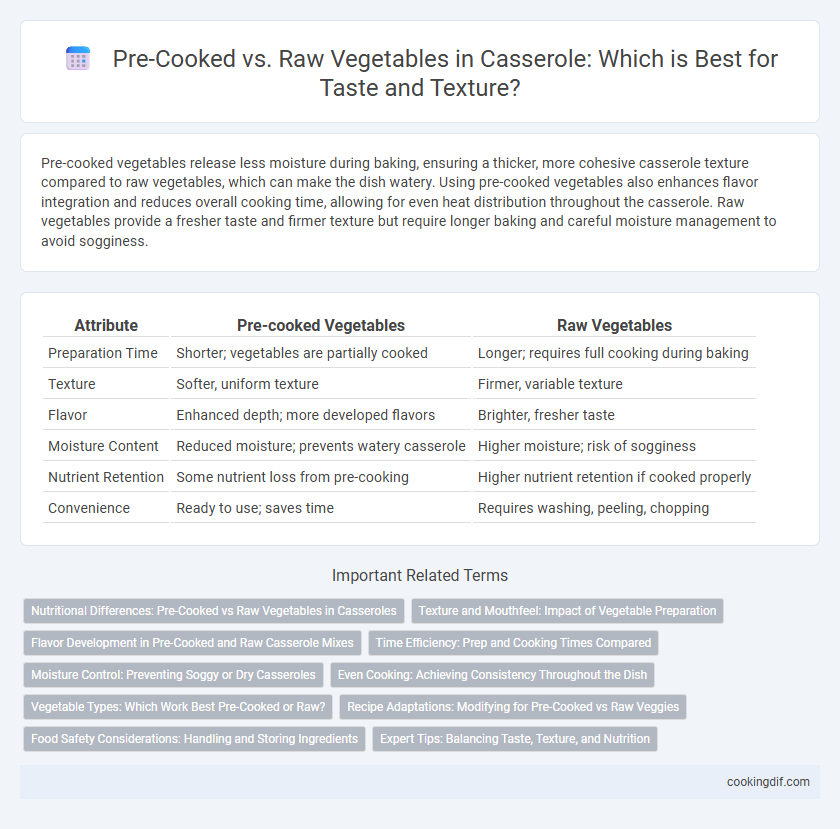Pre-cooked vegetables release less moisture during baking, ensuring a thicker, more cohesive casserole texture compared to raw vegetables, which can make the dish watery. Using pre-cooked vegetables also enhances flavor integration and reduces overall cooking time, allowing for even heat distribution throughout the casserole. Raw vegetables provide a fresher taste and firmer texture but require longer baking and careful moisture management to avoid sogginess.
Table of Comparison
| Attribute | Pre-cooked Vegetables | Raw Vegetables |
|---|---|---|
| Preparation Time | Shorter; vegetables are partially cooked | Longer; requires full cooking during baking |
| Texture | Softer, uniform texture | Firmer, variable texture |
| Flavor | Enhanced depth; more developed flavors | Brighter, fresher taste |
| Moisture Content | Reduced moisture; prevents watery casserole | Higher moisture; risk of sogginess |
| Nutrient Retention | Some nutrient loss from pre-cooking | Higher nutrient retention if cooked properly |
| Convenience | Ready to use; saves time | Requires washing, peeling, chopping |
Nutritional Differences: Pre-Cooked vs Raw Vegetables in Casseroles
Pre-cooked vegetables in casseroles have reduced vitamin C and B vitamin content compared to raw vegetables due to heat-sensitive nutrient loss during cooking. Raw vegetables retain higher levels of antioxidants and enzymes, which can enhance the nutritional profile of casseroles when added just before baking. However, pre-cooking vegetables can improve digestibility and nutrient bioavailability by breaking down cell walls, making some minerals easier to absorb.
Texture and Mouthfeel: Impact of Vegetable Preparation
Pre-cooked vegetables in casseroles offer a softer, more uniform texture, enhancing the overall mouthfeel by blending seamlessly with other ingredients. Raw vegetables retain a firmer, more distinct crunch that provides contrast and adds complexity to each bite. Choosing between pre-cooked and raw vegetables directly impacts the casserole's texture dynamics and can influence moisture distribution and cooking time.
Flavor Development in Pre-Cooked and Raw Casserole Mixes
Pre-cooked vegetables in casserole mixtures enhance flavor through caramelization and Maillard reactions, creating deeper, richer taste profiles compared to raw vegetables. Raw vegetables release more water during baking, which can dilute flavors and result in a milder taste. Incorporating pre-cooked vegetables improves texture consistency and intensifies overall flavor development in casseroles.
Time Efficiency: Prep and Cooking Times Compared
Using pre-cooked vegetables in casseroles significantly reduces overall cooking time by eliminating the need for lengthy sauteing or steaming, allowing faster assembly and baking. Raw vegetables require more prep time to soften during cooking and can extend the total bake time to ensure even doneness throughout the dish. Time efficiency favors pre-cooked vegetables for quicker meal preparation without sacrificing flavor or texture in casseroles.
Moisture Control: Preventing Soggy or Dry Casseroles
Pre-cooked vegetables release excess moisture during baking, which helps prevent soggy casseroles by allowing better moisture control throughout cooking. Raw vegetables retain more water initially, often leading to excess liquid and a watery casserole unless properly drained or adjusted. Balancing pre-cooked and raw vegetables ensures optimal texture by maintaining the casserole's moisture without becoming dry or overly moist.
Even Cooking: Achieving Consistency Throughout the Dish
Pre-cooked vegetables in casseroles ensure even cooking by softening ingredients before baking, preventing undercooked, crunchy bits. Raw vegetables can release excess moisture during baking, potentially causing uneven texture and longer cooking times. Using pre-cooked vegetables optimizes consistency and uniformity, resulting in a cohesive, well-blended casserole.
Vegetable Types: Which Work Best Pre-Cooked or Raw?
Root vegetables like carrots, potatoes, and beets benefit from pre-cooking to ensure tenderness and even cooking in casseroles, while softer vegetables such as zucchini, spinach, and bell peppers can be added raw to maintain texture and freshness. Pre-cooked cruciferous vegetables like broccoli and cauliflower release fewer watery juices, preventing soggy casseroles, whereas raw versions may introduce excess moisture. Selecting the appropriate cooking method based on vegetable type enhances casserole flavor balance and consistency.
Recipe Adaptations: Modifying for Pre-Cooked vs Raw Veggies
Using pre-cooked vegetables in casseroles reduces overall baking time and ensures even cooking, while raw vegetables release more moisture and may require longer cooking to soften. Adjust liquid ratios accordingly; decrease added liquids with pre-cooked veggies to prevent sogginess, and increase liquids or cover during cooking when using raw vegetables to promote proper tenderness. Recipe adaptations should consider texture differences, as pre-cooked vegetables yield a softer consistency compared to the firmer bite of raw vegetables after baking.
Food Safety Considerations: Handling and Storing Ingredients
Pre-cooked vegetables in casseroles reduce the risk of undercooking and help ensure even heat distribution, minimizing bacterial growth during baking. Raw vegetables require thorough washing and proper storage at temperatures below 40degF (4degC) to prevent contamination by pathogens such as Salmonella or Listeria. Storing ingredients separately and using airtight containers further preserves freshness and inhibits cross-contamination, critical for food safety in casserole preparation.
Expert Tips: Balancing Taste, Texture, and Nutrition
Pre-cooked vegetables offer a softer texture and intensified flavor, ensuring even cooking and reducing the risk of undercooked spots in casseroles. Raw vegetables retain more nutrients and provide a firmer bite, but require careful chopping and longer baking times to fully soften. Experts recommend combining both, precooking dense vegetables like carrots and potatoes while adding softer raw vegetables later to balance taste, texture, and nutritional value effectively.
Pre-cooked vegetables vs Raw vegetables for casserole mixture Infographic

 cookingdif.com
cookingdif.com